Florabest FLB 3000 A1 User Manual

ELECTRIC Leaf BLower FLB 3000 A1
GB IE |
GR CY |
ELECTRIC Leaf BLower |
Ηλεκτρικός φυσητήρας- |
Translation of original operation manual |
απορροφητήρας φύλλων |
|
Μετάφραση των αυθεντικών οδηγιών λειτουργίας |
IAN 89769
GB IE
CY
GB / IE |
Translation of original operation manual |
Page |
6 |
GR / CY |
Μετάφραση των αυθεντικών οδηγιών λειτουργίας |
Σελίδα |
17 |
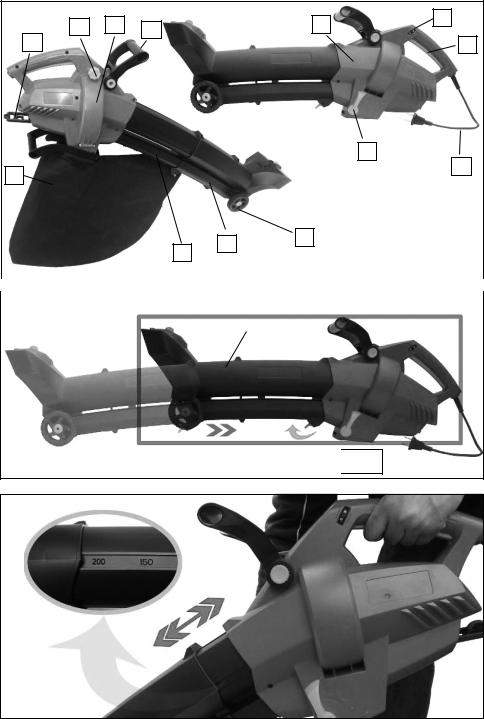
1 |
|
11 |
12 |
13 |
1 |
2 |
|
|
3 |
||||
|
10 |
|
|
|
||
|
|
|
|
5 |
|
9 |
|
|
4 |
||
|
|
|
|
||
|
|
8 |
7 |
6 |
|
|
|
|
|
||
|
|
|
|
|
|
|
|
|
|
|
|
|
|
|
|
|
|
|
|
|
|
|
|
2 |
|
|
|
|
|
|
|
2.2 |
|
||
|
|
|
|
||

 2.1
2.1
3
A

4 |
|
5 |
|
|
|
6
6.2 6.1
7
7.1
B
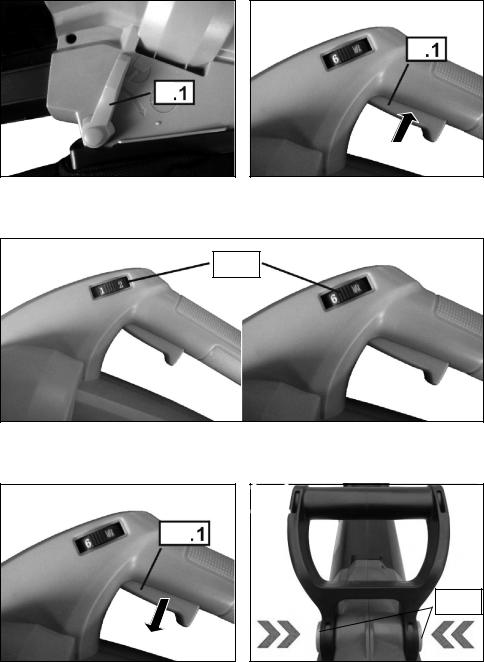
8 |
9 |
9
8
10 |
10.1 |
|
11 |
12 |
11
12.1
C
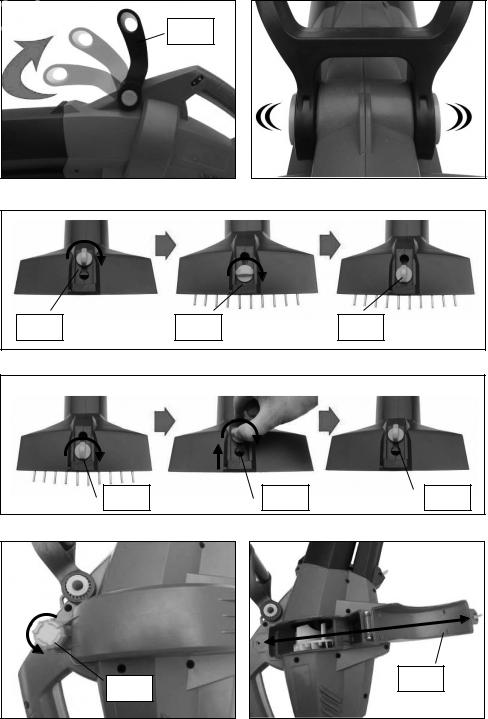
13 |
13.1 |
14 |
|
|
15
15.1 |
15.2 |
|
15.3 |
16 |
|
|
|
|
16.1 |
16.2 |
16.3 |
17 |
|
18 |
|
17.1 |
18.1 |
|
|
D

GB IE
Content
Illustrations |
A-D |
Introduction |
6 |
Intended use |
6 |
Scope of deliverables |
6 |
Description of product |
6 |
Unpacking |
6 |
Technical Specifications |
7 |
Safety symbols |
7 |
General safety instructions |
8 |
Training |
8 |
Preparation |
8 |
Operation |
8 |
Maintenance and storage |
8 |
Safe operation |
9 |
Personal safety |
9 |
Careful handling of tools |
9 |
Specialsafetyinstrucionsleafblowers/vacuums 10
Preparing of the blower vac prior to use 11
Assembly |
11 |
Intake/ Air outlet tube |
11 |
Fitting the debris collection bag |
11 |
instructions are a constituent part of this product. They contain important information for safety, operation and disposal. Familiarise yourself with all operating and safety instructions prior to using the product. Use the product only as described and for the areas of application stated. If the device is passed on to a third party then pass all of the documentation on with it.
Intended use
The leaf vac is exclusively used in the two following ways:
1.As a leaf vac for vacuuming up dry leaves.
2.As a blower it is used to collect together dry leaves or to remove them from inaccessible places (e.g. under vehicles).
In suction mode it also works as a shredder, where the volume of the leaves is reduced by a ratio of approx. 15:1 and takes up less space in the leaf collection bag and the collected material is simultaneously prepared for possible composting.
Each type of use other than those given in these instructions for use can damage the machine and cause serious risk to the user.
Fitting the shoulder harness |
12 |
Please always observe the safety instructions in order |
||
Before starting |
12 |
tosafeguardyourguaranteeclaimandintheinterests |
||
Operation |
12 |
ofproductsafety.Duetothemachine’sdesign,weare |
||
Starting the Vacuum-Blower |
12 |
unable to fully exclude all residual risks. |
||
Stopping the VacuumBlower |
12 |
Scope of deliverables |
||
Using the Vacuum-Blower |
12 |
Description of product (Fig. 1) |
||
Blower mode |
12 |
|||
Vacuum mode |
12 |
1 |
Motor housing |
|
Adjust the front handle |
13 |
2 |
Adjusting speed controller |
|
Using the leaf rake |
13 |
3 |
ON/OFF-Switch |
|
Cleaning flap |
13 |
4 |
Power cord & plug |
|
Cleaning and Storage |
13 |
5 |
Selection knob |
|
Power Cord Maintenance |
13 |
6 |
Wheel |
|
Troubleshooting |
13 |
7 |
Lower tube |
|
8 |
Upper tube |
|||
Waste disposal and environmental protection14 |
||||
9 |
Collection bag |
|||
EC Declaration of Conformity |
14 |
|||
10 |
Cable strain relief |
|||
Guarantee |
14 |
|||
11 |
Screw plug |
|||
Repair service |
15 |
12 |
Cleaning flap |
|
Spare parts |
15 |
13 |
Front handle |
|
Warranty card |
16 |
14 |
Shoulderbelt |
|
Explode drawing |
33 |
15 |
Operating Instructions |
|
Introduction
Congratulations on the purchase of your new device. Youhavechosenahighqualityproduct.Theoperating
Unpacking
Due to modern mass production techniques, it is unlikely that your power tool is faulty or that
6
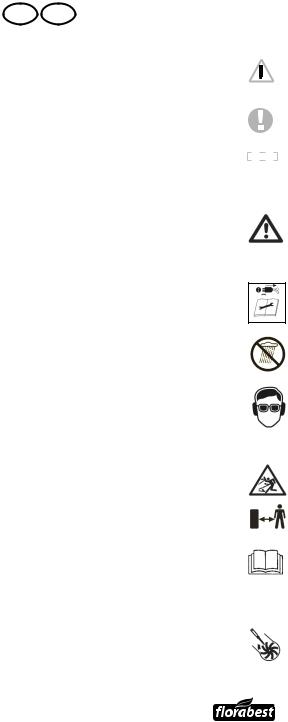
GB IE
a part is missing. If you find anything wrong, do not operate the tool until the parts have been replaced or the fault has been rectified. Failure to do so could result in serious personal injury.
Technical Specifications
Electric Leaf Blower |
FLB 3000 A1 |
Rated voltage |
230-240 V~ |
Rated frequency |
50 Hz |
Rated power consumption |
3000 W |
Fuse (time lag) |
16 A |
Rotation |
10000-16500 rpm |
Max. blowing speed |
27-79 m/s |
High blow volume |
10-15 m3/min. |
Bag volume |
50 l |
Weigth (without cable) |
4,8 kg |
 Protection class II/VDE 0700
Protection class II/VDE 0700
The A-rated sound pressure level of the device measured in accordance with DIN 45635 Part1, Appendix D is:
Sound power level
LWA 104 dB(A) [K: 2,6 dB(A)] 2000/14/EG Weighted sound pressure
LpA 87,8 dB(A) [K: 3 dB(A)] 2000/14/EG Vibration max.
< 2,5 m/s² [K 1,5 m/s2] EN ISO 20643:2008
 Please wear ear protectors!
Please wear ear protectors!
Noise emission information in accordance with the German Product Safety Act (ProdSG) and the EC Machine Directive: the noise pressure level at the place of work can exceed 80 dB(A). In such cases the operator will require noise protection (e.g. wearing of ear protectors).
Safety symbols
In the following, you will find the description of safety symbols as well as international symbols and pictograms that may appear on your device. It is required that you read all safety notes before you operate the device. If you do not use this Blower Vacuum device properly, personal injuries through fire, electric shock or cutting parts or property damages may occur.
Please keep these Operating instructions carefully!
7
Symbols used in the instructions
Hazard symbol with information on prevention of personal injury and property damage.
|
|
|
Precaution symbol (explanation of precaution |
|
|
|
partly instead of exclamation mark) with in- |
|
|
|
formation on prevention of harm / damage. |
|
i |
|
Notice symbol with information on how to |
|
|
||
|
|
|
handle the device properly. |
|
|
|
|
|
|
|
Symbols on the device
WARNING SYMBOL
Indicates danger, safety notes or causes for particular caution. This symbol may occur in combination with other symbols or pictograms.
Disconnect mains plug before carrying out any repairs!
If the cable is damaged, disconnect from the mains immediately and replace cable!
OPERATION AND STORAGE
Do not use the device in humid weather and store it in a dry location.
WEAR EYE AND EAR PROTECTION WARNING: Thrown-about objects may lead to serious injuries of the eyes, heavy noise may lead to hearing losses. Always wear eye and ear protection when operating this device.
KEEP OTHER PERSONS IN DISTANCE WARNING: When operating the device, takecarethatnootherpersonsarenearby (safe distance: 5m). This is particularly valid for children and animals.
READ THE OPERATING INSTRUCTION
If you do not observe the operating and safety notes of the Operating Instructions, serious injuries may occur. Read the Operating Instructions before you switch on and operate this device.
WARNING!
Rotating Fans. Keep tools out of the openings while the machine is running.
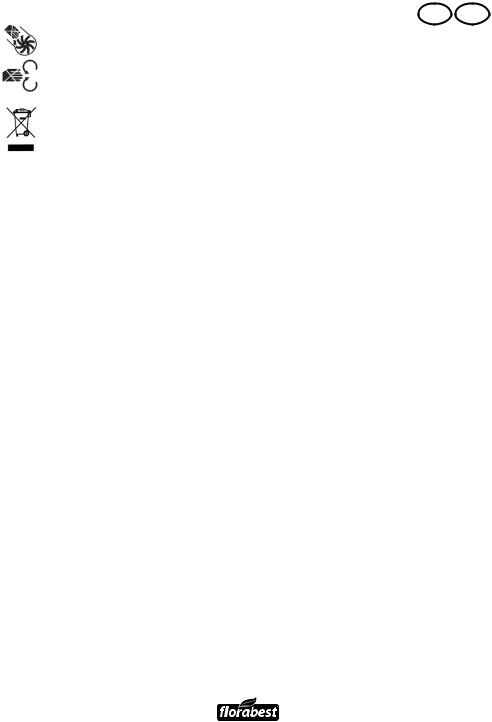
WARNING!
Dangerous feed orifice. Keep hands and feet out of the openings while the machine is running.
Attention: Environmental Protection!
This device may not be disposed of with general/household waste. Dispose of only at a designated collection point.
General safety instructions
You must read, understand and follow these operating instructions very carefully before operating this machine. They should guarantee your safety and the safety of others and should ensure a long and fault-free service life for your machine.
Training
•Read through the operating instructions carefully. Familiarise yourself with the controls and the proper use of the device.
•Never allow the device to be used by children.
•Never permit children or persons who are not familiar with these operating instructions to use this device. The age of the operator may be stipulated by local regulations.
•Never operate the device whilst other persons, in particular children or animals, are nearby.
•Theoperatororuserisresponsibleforallaccidents or hazards to other persons or their property.
Preparation
•Always wear sturdy shoes and long trousers when operating the device.
•Do not wear loose clothing or jewellery as these can be drawn into the air intake. Keep long hair away from the air intake.
•Wear safety goggles during operation.
•The wearing of a face mask for protection from dust is recommended.
•Before using check the power supply cable and the extension cable for damage and signs of ageing. Do not use the device if the cable is damaged or worn out.
•Never operate the device with faulty coverings or safety devices or with safety devices missing - the attached debris bag for example.
•Only use weather-resistant extension cables with sockets and plugs that comply with the IEC standard 60320-2-3.
GB IE
Operation
•Always lead the cable rearwards away from the device.
•If a cable is damaged during operation then disconnect the power supply cable from the powersourceimmediately.DONOTTOUCHTHE CABLE BEFORE YOU HAVE DISCONNECTED IT FROM THE MAINS.
•If the connection cable is damaged it must be replaced by the manufacturer, a maintenance representative of the manufacturer or similarly qualified persons in order to exclude possible hazards. If an extension cable is used, then this must be dimensioned per H05VV-F (2 x 1.0 mm2) or better.
•Do not carry the device by the cable.
•Disconnect the device from the power supply,
-If you leave the device,
-Before you remove potential blockages,
-Before you check, clean or work on the device,
-Ifthedevicestartstoproduceunusualvibrations.
•Only operate the device during daylight or with good artificial lighting.
•Do not lean too far forward and keep your balance at all times.
•Always make sure that you have stable footing on slopes.
•Walk, never run.
•Keep all air intakes free of foreign bodies.
•Never blow debris towards bystanders.
•Itisrecommendedthatthedeviceisonlyoperated at reasonable times of the day - so not early in the morning or late in the evening - when people could be disturbed by this.
•It is recommended to loosen debris with rakes and brushes first and only then to start with the blowing or vacuuming.
•It is recommended that dusty surfaces be lightly dampened or that a mister is used.
•It is recommended to work with the full blast tube length so that the air flow can work close to the ground.
Maintenance and storage
•Ensure that all nuts, bolts and screws are firmly tightened so that the device is constantly in a safe working condition.
•Check the debris bag for wear or damage regularly.
•Replace parts that are worn out or damaged.
8

GB IE
•Use only original replacement parts and original accessories.
•Only store the device in dry locations.
Safe operation
Familiarise yourself with your power tool. You must have read and understood the operating instructionsandalladhesivelabelsonyourpower tool. Familiarise yourself with the applications and operational limitations as well as potential hazard sources of this power tool.
Working area
Untidyworksurfacesandworkingareascanconceal accident risks. For that reason workbenches should be kept orderly. Floors should be kept clear and free of waste. Particular care is required where the flooring is slippery due to sawdust or floor polish.
Working environment
Do not let your power tool come into contact with rain and do not use it in damp or wet locations. Ensure there is always good lighting for the working area. Do not use the power tool in areas in which there is a risk of explosions or fires due to combustible materials, inflammable liquids, paint, varnish, benzine etc. Combustible gases and dust are explosive by their nature.Asaprecautionarymeasure,itisrecommended toconsultwithanexpertwhocanadviseyouofhowto procureanduseanappropriatefireextinguisher.
Protection from electric shocks
Avoid bodily contact with earthed surfaces (e.g. pipes, radiators, electric cookers, fridges).
Keep away from children and pets
Children and pets should be kept out of the working area. Ensure that children do not handle the machine and do not touch any extension cables. All power tools should be kept out of reach of children and should preferably be kept in a secure cabinet or room when not in use.
Do not overload the power tool
The power tool works better and more safely and will benefit you much more if you use it within the operational limits for which it was designed.
Use the correct tool
Select the correct tool for your task. Do not use tools for purposes other than those for which they were intended. Do not overload small tools with tasks for which high performance tools are required. Only
9
use tools for their designed purpose. Example: Do not use circular saws for sawing branches or logs.
Personal safety
Clothing
Do not wear loose clothing or jewellery as these can be caught by moving machine parts.
Hair
Long hair should be tied back and covered with a protective hair net or similar.
Eye protection
Wearing of goggles is mandatory (normal spectacles are not sufficient for protecting the eyes). Prescription spectacles do not have safety glass.
Hearing protection
Hearing protection is recommended with extended periods of use.
Footwear
If heavy objects could fall on your feet or if there is a risk of slipping on wet or slippery ground, then suitable non-slip safety footwear should be worn.
Protective headgear
If heavy objects could fall on your head or if there is a riskofstrikingyourheadonprojectingorlowobstacles, thenahard-hatorsafetyhelmetshouldbeworn.
Respiratory protection
If dust is caused when operating the machine then wear a dust protection mask. When working with concrete or synthetic fibre boards, in particular MDF sheets (medium density fibreboard) the resin used in these materials can present a health risk. Use an approved face mask with a replaceable filter.
Do not mechanically overload the mains cable
Never disconnect the mains cable plug from the outlet by pulling or tugging on the cable. Never carry your power tool by its cable. Keep the cable away from heat, oil, solvents and sharp edges. If the cable should be damaged then have this replaced by an approved customer support centre.
Do not lean too far forward
Do not lean too far forward, make sure you have a stable footing and keep your balance at all times.
Careful handling of tools
Keepcuttingtoolssharpandclean.Thiswillprovide
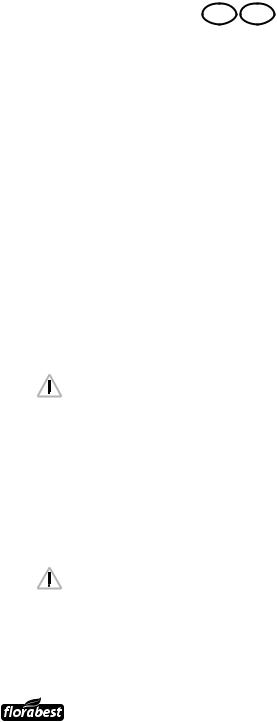
you with better results and increased safety. Follow the instructions for lubrication and for replacing accessory parts.
Check the mains cable for the tool regularly. If it should be damaged then have this replaced by an approved customer support centre.
Check the extension cable regularly and replace it if it is damaged.
Keep grips dry, clean and free of oil and grease. Take care to ensure that the ventilation slots are always clear and free of dust. Blocked ventilation slots can lead to overheating and can damage the motor.
Disconnect the power tool from the mains
Ensure that the power tool is disconnected from the mains when not in use, before it is serviced or lubricated, before adjustments are carried out on it, or when accessory parts such as blades, drill bits and cutters are replaced.
Removal of adjustment wrenches
Make it a consistent practice to always check that there are no adjustment wrenches remaining on the power tool before you switch it on.
Avoidance of unintended switching on
Ensure that the switch is in the OFF position before you connect the power tool to the mains.
Extension cables and cable drums
The device shouldbeoperatedviaaresidualcurrent circuit breaker (RCD) with a triggering current of max. 30 mA.
DO NOT USE cable drums or extension cables with a two-core cable to operate a power tool with an earth wire. Always use an extension cable or cable drum with a three-core cable whose earth wire is connected.
If the power tool is to be used outdoors, use only extension cables that are intended for outdoor use and which are labelled as such.
Always unroll extension cables completely. Extension cables must have a conductor cross section of at least 1.5 mm2.
Damaged extension cables must not be used but rather must be replaced.
Protect your extension cable from sharp edged objects or from excessive heat and moisture or wet locations.
Stay alert
Proceed cautiously, use your common sense and do not operate the power tool if you are tired, if
GB IE
you are taking medication that makes you drowsy or if you have consumed alcohol or drugs.
Checking of damaged parts
The power tool should be carefully checked before use to ensure that it is working properly and fulfilling its intended purpose.
Check that the moving parts are correctly aligned and ensure that they are able to move freely. Check the tools for damaged or missing parts and if necessary have these replaced or repaired at an authorised customer support centre. If the power tool has to be mounted then ensure that it is safely secured on a suitable workbench. Check all other conditions that could have an influence on the operation of the power tool.
If protective coverings or other parts of the power tool are damaged then these should be replaced or repaired in an authorised customer support centre insofar as these operating instructions do not specify otherwise.
Any switch that does not work flawlessly must be replaced by an authorised customer support centre. Do not use the power tool if the On-Off switch of the power tool does not switch on and off securely and reliably.
Warning ! Do not carry out any alterations to the power tool. The use of attachments or accessories other than those recommended in these operating instructions could damage the power tool and could present a risk of injury for the operator. Have your power tool repaired by a qualified person.
Thispowertoolfulfilsthenationalandinternational standards and safety requirements. Repairs should only be carried out by qualified persons using original replacement parts. Otherwise there may be considerable hazards for the user.
Special safety instrucions leaf blowers/ vacuums
Warning against use by children!
Never let children or persons who have not read and understood these operating instructions use the leaf blower/vacuum. Do not use the leaf blower/vacuum for purposes other than those described in these operating instructions.
Read the warning labels on the machine and replace any damaged or illegible warning labels. Read through these operating instructions
10
